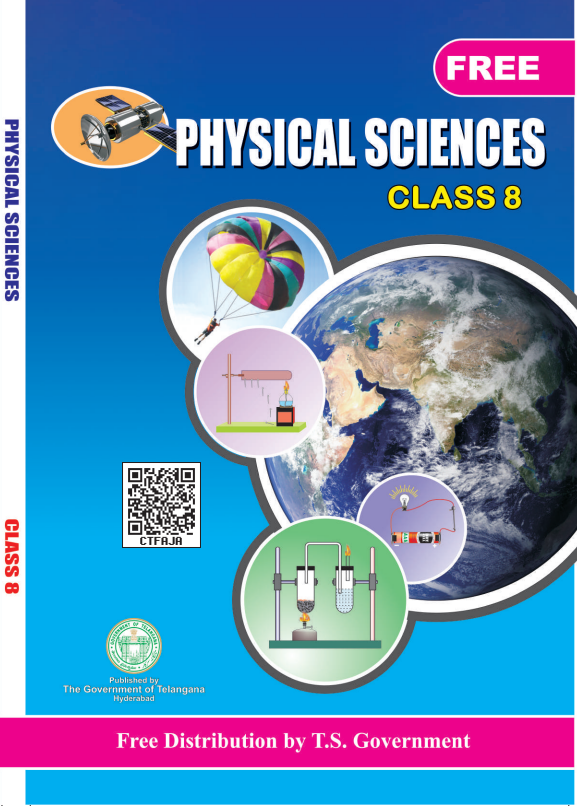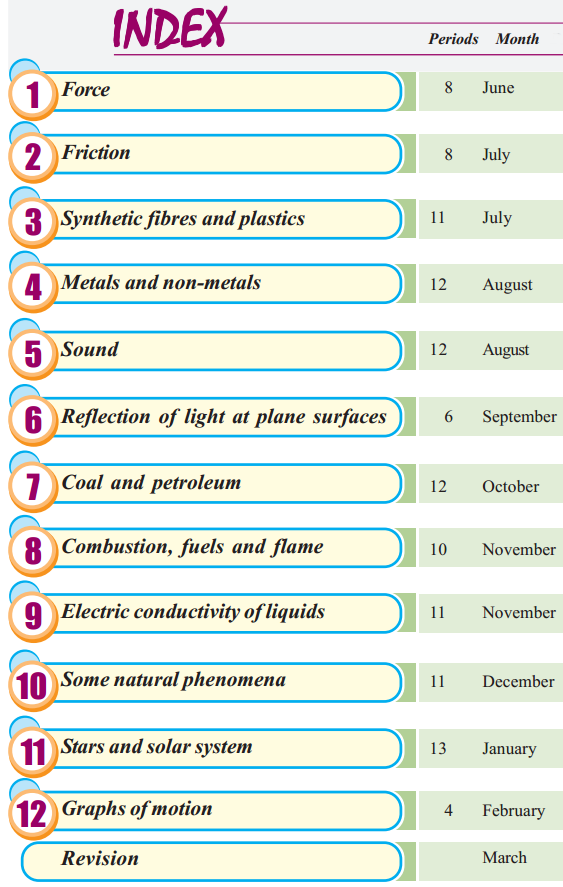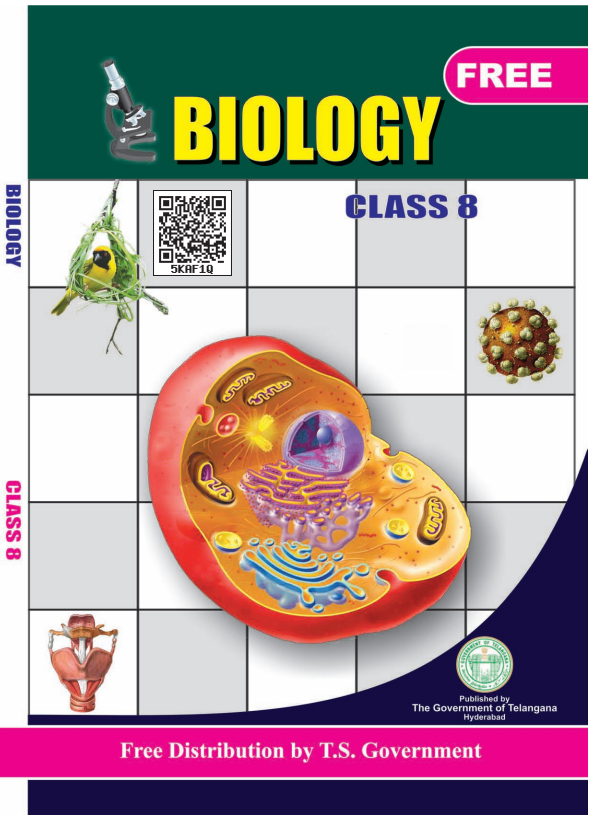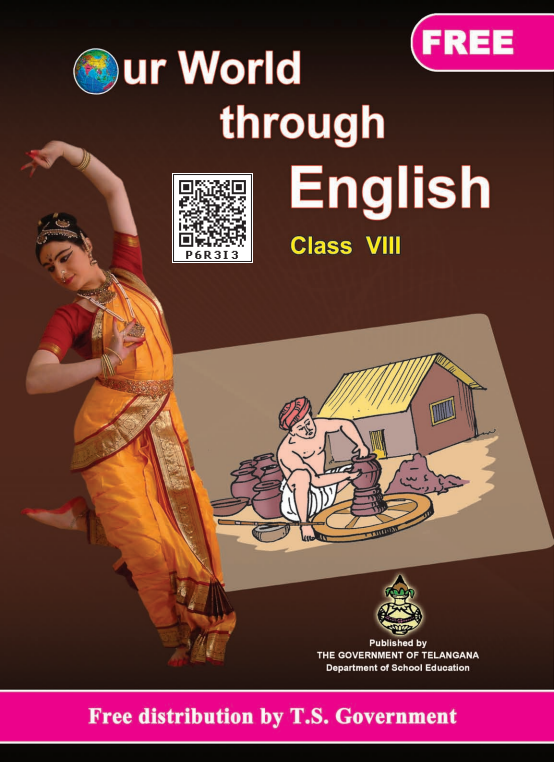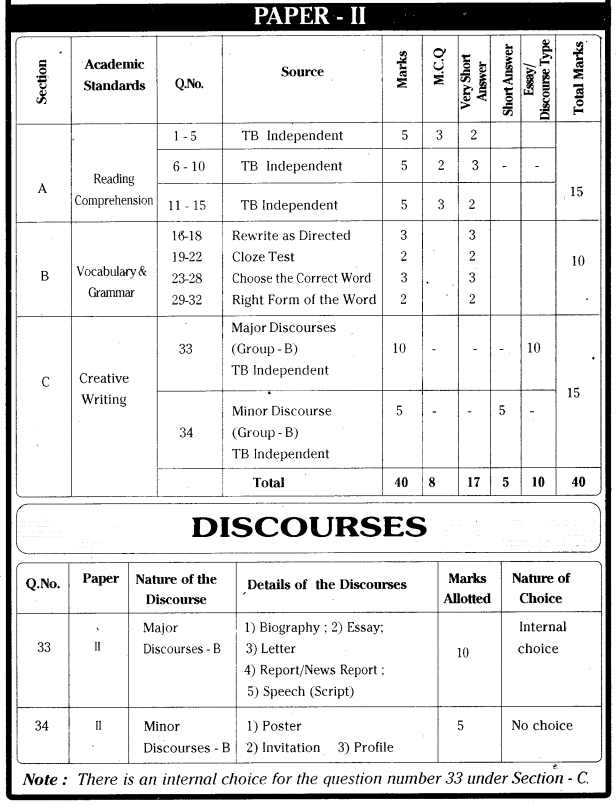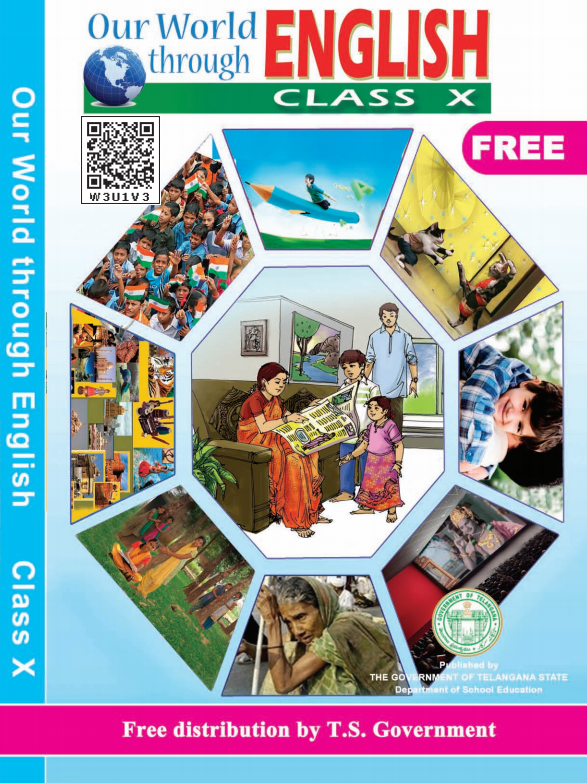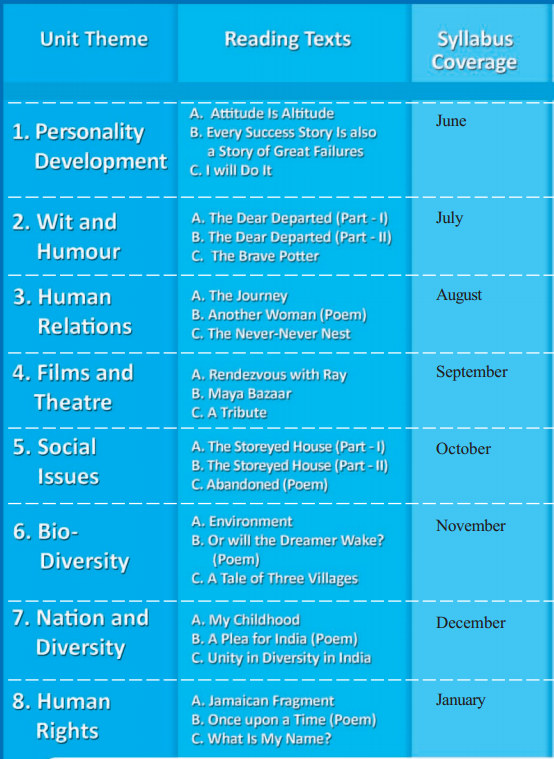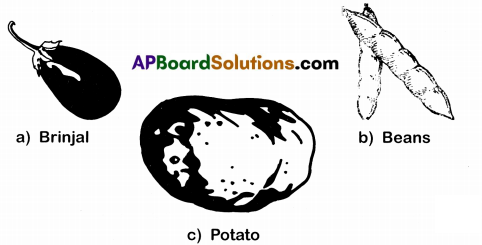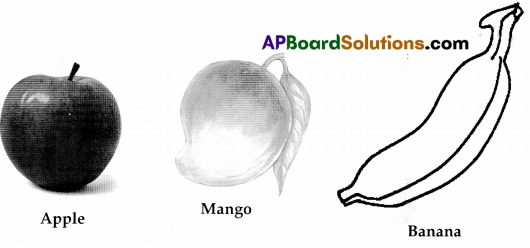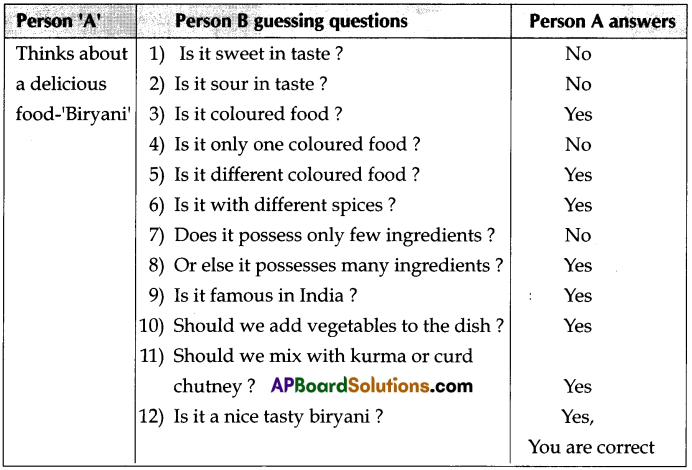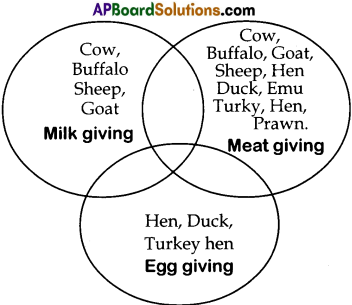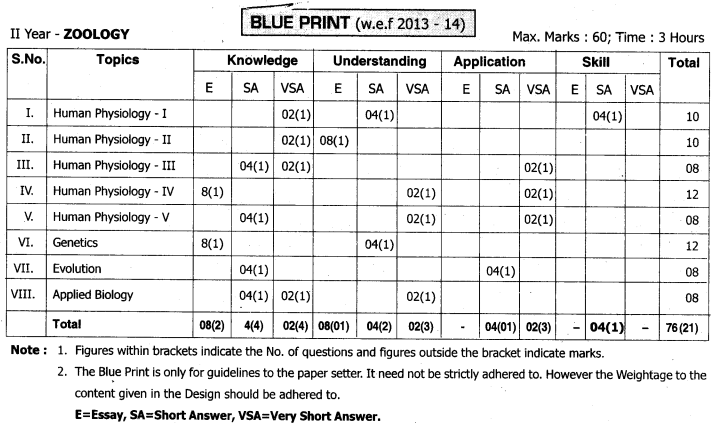Telangana SCERT TS 8th Class Hindi Guide Pdf Grammar हिंदी व्याकरण Questions and Answers.
TS 8th Class Hindi Grammar Questions and Answers
वर्ण : (అక్షరములు) :
मुँह से निकलनेवाली ध्वनियों से लिखित चिह्न को वर्ण कहते हैं।
(నోటి నుండి వెలువడే ధ్వనులచే వ్రాయబడిన చిహ్నమును అక్షరము అంటాము.)
जैसे : अ, इ, च, ज आदि
ఉదా : అ, ఇ, చ, జ మొ॥నవి.
ध्वनि बोलने और सुनने में आती है लेकिन वर्ण लिखने में आता है।
(ధ్వని మాట్లాడుటకు, వినుటకు వస్తుంది కాని అక్షరము వ్రాయుటలోనే వస్తుంది.)
वर्णों के समुदाय को वर्णमाला कहते हैं।
(అక్షరముల సముదాయమును “హిందీలో, వర్ణములు అంటారు.)
हिन्दी वर्णमाला में 44 वर्ण हैं, जिन्में 11 स्वर हैं, और 33 व्यंजन हैं।
(హిందీ భాషలో మొత్తము 44 అక్షరములు కలవు. వానిలో 11 అచ్చులు, 33 హల్లులు).

स्वर : (అచ్చులు) Vowels :

व्यंजन : (హల్లులు) Consonants :
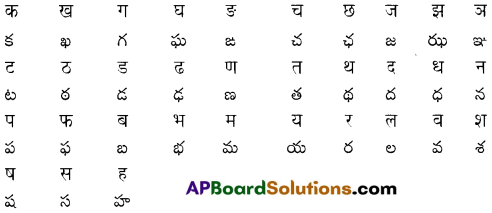
सूचना (సూచన) : क्ष, त्र, ज्ञ (క్ష, త్ర, జ్ఞ) संयुक्ताक्षर हैं। (సంయుక్తాక్షరములు)
1. स्वर वर्ण (అచ్చులు) :- जो वर्ण किसी अन्य वर्ण की सहायता के बिना अकेले ही बोले जा सकते हैं, उन्हें स्वर वर्ण कहते हैं।
(ఇతర అక్షరము సహాయం లేకుండా స్వతంత్రంగా పలుకబడే అక్షరములను అచ్చులు అంటారు.)
2. व्यंज्न (హల్లులు) :- जिन वर्णों का उच्चारण स्वरों की सहायता से होता है, उन्हें व्यंजनवर्ण कहते हैं। हिन्दी के व्यंजन इस प्रकार हैं।
(అచ్చుల సహాయము లేనిదే తమంత తాము ఉచ్చరింపబడలేని అక్షరములను హల్లులు అంటారు. హిందీలో హల్లులు ఈ విధముగా ఉన్నవి.
जैसे (ఉదా) : क, ख, ग, घ ….. श, ष, स, ह
स्वरों के भेद (అచ్చులలో బేధములు), उत्पत्ति के अनुसार स्वरों के दो भेद हैं।
1. मूल स्वर
2. संधि स्वर
मूल स्वर : जो किसी अन्य स्वर से नहीं बने हैं। उदा : अ, इ, उ, ॠ
संधि स्वर : जो मूल स्वरों के योग से बने हैं । उदा : आ, ई, ऊ, ए, ऐ, ओ, औ

बारह खडी (मात्राएँ) (గుణింతములు) :
व्यंजन के साथ स्वर जिस रूप में मिला होता है, उसे स्वर की मात्रा कहते हैं।
(హల్లుతోపాటు అచ్చు కలిసిన రూపమును గుణింత చిహ్నము అంటారు)
प्रत्येक स्वर की मात्रा नीचे दी जा रही है।
स्वर : अ आ इ ई उ ऊ ऋए ऐे औ
मात्रा :

‘अ’ की कोई मात्रा नहीं होती । “अ’’ स्वर व्यंजन में ही मिला रहता है। जैसेः क् + अ = क, ज् + अ = ज सभी स्वरों की मात्राएँ क्रम से “क” के साथ नीचे दी जा रही हैं-
क् + अ = क
क + उ = कु
क + ऐ = कै
क + आ = का
क + ऊ = कू
क + औ = को
क + इ = कि
क + ॠ = कृ
क + औ = कौ
क + ई = की
क + ए = के
स्वरों के भेद (ఆచ్చులలో భేదములు) :
स्वर दो प्रकार के होते हैं।
1) हस्व स्वर
2) दीर्घ स्वर
(అచ్చులు రెండు రకములు)
1) హ్రస్వాక్షరములు
2) దీర్ఘాక్షరములు
हस्व स्वर : अ, इ, उ, ॠ (అ, ఇ, ఉ, ఋ)
दीर्घ स्वर : आ, ई, ऊ, ओ, औ आदि (ఆ, ఈ, ఊ, ఓ, ఔ)

द्विवत्वादर (ద్విత్వాక్షరములు) :
दो सजातीय व्यंजनों से बने वर्ण को द्विवत्वाक्षर कहते हैं।
(రెండు ఒకే రకమైన హల్లులచే ఏర్పడిన అక్షరమును ద్విత్వాక్షరము అంటారు.)
उदा : क, ग्ग, प्प, स्स, म्म, य्य, र
संयुक्ताकर (సంయుక్తాక్షరములు) :
अलग-अलग व्यंजनों के मेल से बने वर्ण को संयुक्ताक्षर कहते हैं।
(వేరు వేరు హల్లుల కలయికతో ఏర్పడిన అక్షరమును సంయుక్తాక్షరము అంటారు.)
उदा : क् + य = क्य (క్య)
श + व = श्व (శ్వ)
स + य = स्य (స్య)
शब्द (శబ్దము/పదము) :
शब्द एक या ज्यादा अक्षरों से बनता है जो कोई चीज़, भाव या काम का बोध करता है।
उदा : घर, कलम, नगर, लड़का
(ఒకటి లేక ఎక్కువ అక్షరములతో ఏర్పడి ఏదేని వస్తువును, భావమును లేదా పనిని సూచించు అక్షర సముదాయము శబ్దము/పదము అనబడును) ఉదా : ఇల్లు, కలము, నగరము, బాలుడు
प्रयोग के अनुसार शब्द दो प्रकार के हैं। (ప్రయోగముననుసరించి శబ్దములు రెండు రకములు)
1. विकारी शब्द (మార్పు చెందే శబ్దములు)
2. अविकारी शब्द (మార్పు చెందని శబ్దములు)
1. विकारी शब्द :- लिंग, वचन, कारक आदि के कारण जिन शब्दों के रूप में परिवर्तन होता है, वे विकारी शब्द कहलाते हैं।
(లింగ, వచన, విభక్తుల కారణములుగా రూపములలో మార్పు వచ్చు శబ్దములు వికారీ శబ్దములు (మార్పు చెందే) శబ్దములు అని పిలువబడతాయి)
ये चार हैं – ఇవి నాలుగు
1. संज्ञा
2. सर्वनाम
3. विशेषण
4) क्रिया
1. నామవాచకము
2. సర్వనామము
3. విశేషణము
4. క్రియ

2. अविकारी शब्द :- जिन शब्दों के रूप में परिवर्तन नहीं होता वे अविकारी शब्द कहलाते हैं।
(శబ్ద రూపములలో మార్పు రానివి, అవికారీ శబ్దములు) ये चार हैं। ఇవి నాలుగు
1. क्रिया विशेषण
2. संबन्ध बोधक
3. समुच्चय बोधक (योजक)
4. विस्मयादि बोधक
1. క్రియావిశేషణము
2. సంబంధ బోధకము
3. సముచ్ఛయ బోధకము
4. విస్మయాది బోధకము.
संज्ञा (నామవాచకము Noun) :
जो शब्द किसी व्यक्ति, वस्तु, स्थान और गुण के नाम बताते हैं उन्हें संज्ञा कहते हैं।
వ్యక్తి, వస్తువు, స్థానము, గుణము యొక్క పేరును తెలియచేయు శబ్దము సంజ్ఞలు అని పిలవబడతాయి.
जैसे : राकेश, सीता, कलम, किताब, दिल्ली
ఉదా : రాకేష్, సీత, కలము, పుస్తకం, ఢిల్లీ
संज्ञा के प्रकार నామవాచకముల రకములు
संज्ञाओं के पाँच प्रक्रार हैं। నామవాచకములు అయిదు రకములు.
1. व्यक्तिबाचक संज्ञा : किसी खास व्यक्ति, वस्तु या स्थान का नाम बतानेवाला शब्द व्यक्तिवाचक संज्ञा है। उदा : गोपाल, गेंद, विजयवाडा
(వ్యక్తి వాచక నామవాచకము : మనిషి, వస్తువు లేదా స్థానము యొక్క పేరును తెలుపు పదమును వ్యక్తి వాచక నామవాచకము అందురు.)
ఉదా : గోపాల్, బంతి, విజయవాడ
2. जातिवाचक संज्ञा (జాతి వాచక నామవాచకము) : – जो संज्ञा एक ही जाति के व्यक्तियों, वस्तुओं के नाम बताता है उसे जातिवाचक संज्ञा कहते हैं। उदा : आदमी, लड़का, नदी, नगर, पहाड़ आदि
(ఒకే జాతికి చెందిన వ్యక్తులు లేదా వస్తువుల పేర్లను తెలుపు పదమును జాతి వాచక నామవాచకము అంటారు.)
ఉదా : మనుష్యుడు, బాలుడు, నది, పట్టణము, పర్వతము మొ||నవి.
3. समूहवाचक संज्ञा (సమూహవాచక నామవాచకము) :- जो संज्ञा एक ही जाति के व्यक्तियों तथा वस्तुओं के समूह का उल्लेख करता है, उसे समूह वाचक संज्ञा कहते हैं।
उदा : झुंड, खिल्नाडी, सेना, लोग
(ఒకే జాతికి చెందిన వ్యక్తులు లేదా వస్తువులను గురించి ఒక మాటలో తెలుపు పదమును సమూహ వాచక నామవాచకము అంటారు.) ఉదా : గుంపు, ఆటగాళ్ళు, సైన్యము, ప్రజలు

4. द्रव्यवाचक संज्ञा (ద్రవ్య వాచక నామవాచకము) :- जो संज्ञा किसी द्रव्य का बोध करती है उसे द्रव्यवाचक संज्ञा कहते हैं। उदा : सोना, तेल, शहद आदि
(ఏదేని ద్రవ్యము తెలియచెప్పు నామవాచకమును ద్రవ్య వాచక నామవాచకము అంటారు.)
ఉదా : బంగారము, నూనె, తేనె మొ॥నవి
5. भावबाचक संज्ञा (భావ వాచక నామవాచకము) :- क्रोध, बचपन, कालिमा, अच्छाई, आदि (వ్యక్తి లేదా వస్తువు యొక్క రంగు, గుణము పరిమాణము తెలుపు పదమును భావవాచక నామవాచకము అంటారు.)
ఉదా : కోపము, బాల్యము, నల్లనిరంగు, మంచితనము మొ॥నవి.)
सर्वनाम (సర్వనామము Pronoun) :
जो शब्द संज्ञा के स्थान में उस का अर्थ-प्रकट करने केलिए प्रयोग किया जाता है, उसे सर्वनाम कहते हैं।
उदा : मैं, वह आप, ये, वे आदि)
(నామవాచకమునకు బదులుగా వాడబడు శబ్దమును సర్వనామము అంటారు).
ఉదా : నేను, అతడు, మీరు, వీరు, ఆ మొ॥నవి)
सर्वनाम के छ: भेद हैं। (సర్వనామమలు ఆరు రకములు.)
1. पुरुष वाचक सर्वनाम (పురుష వాచక సర్వనామము) :- जिस सर्वनाम से बोलनेवाले, सुननेवाले और विषय से संबन्ध रखनेवाले का पता चलता है, उसे पुरुष वाचक सर्वनाम कहते हैं।
उदा : तुम, हम, वह, वे, यह
(మాట్లాడువాడు, వినువాడు లేదా విషయంతో సంబంధం ఉన్న వాడిని గురించి తెలిపే సర్వనామమును పురుషవాచక సర్వనామము అంటారు.)
ఉదా : నీవు, మేము, అతడు, వారు, ఇతడు
2. निश्चय वाचक सर्वनाम (నిశ్చయ వాచక సర్వనామము) :- सर्वनाम निश्चयवाचक होते हैं जो किसी बात का निश्चय सूचित करें। उदा : यह, वह, ये, वे।
ప్రత్యేక స్థితిని తెలియజేయు సర్వనామమును నిశ్చయవాచక సర్వనామము అంటారు.
ఉదా : ఇది, ఇతడు, ఈమె, అది, అతడు, వాడు, వీరు, ఇవి, ఈ, వారు, అవి, ఆ)

3. अनिश्चय वाचक सर्वनाम (అనిశ్చయవాచక సర్వనామము) :- जो किसी विशेष व्यक्ति या वस्तु का बोध नहीं करते, वे अनिश्य वाचक सर्वनाम होते हैं।
उदा : कोई, कुछ, सब
(ప్రత్యేక వ్యక్తి లేదా వస్తువు గురించి తెలుపని సర్వనామములు అనిశ్చయ వాచక సర్వనామములు)
ఉదా : కొన్ని, కొంత, అందరు.
विशेषण (విశేషణము Adjective) :
जो शब्द संज्ञा या सर्वनाम की कोई विशेषता या गुण प्रकट करता है उसे विशेषण कहते हैं।
उदा : बडा पेड, मोटा लडका, चार केले।
(నామవాచకము లేదా సర్వనామము యొక్క గుణమును తెలుపు పదమును “విశేషణము” అంటారు.)
ఉదా : పెద్ద చెట్టు, లావైన బాలుడు, నాలగు అరటిపండ్లు.
विशेषण चार प्रकार के हैं। (విశేషణములు నాలుగు రకములు)
1. गुण वाचक विशेषण (గుణవాచక విశేషణము) :- जिस विशेषण से संज्ञा या सर्वनाम के गुण, आकार, रंग, स्थान, दशा, काल, अवस्था आदि का बोध हो, उसे गुण वाचक विशेषण कहते हैं।
उदा : अच्छा, नाटा, सफेद, ऊँचा आदि
(నామవాచకము, సర్వనామము యొక్క గుణము, ఆకారము, రంగు, స్థానము, దశ, కాలము, స్థితి మొుగు వాటిని తెలియచేయు విశేషణమును గుణవాచక విశేషణము అంటారు.)
ఉదా : మంచి, పొట్టి, తెలుపు, ఎత్తు మొ॥నవి.

2. संख्या वाचक विशेषण (సంఖ్యావాచక విశేషణము) :- जिस विशेषण से संज्ञा या सर्वनाम की संख्या का बोध हो उसे संख्या वाचक विशेषण कहते हैं।
उदा : पहला, नौ, चारों आदि
(నామవాచకము లేదా సర్వనామము యొక్క సంఖ్యను తెలియచేయు విశేషణమును సంఖ్యవాచక విశేషణము అందురు) ఉదా : ఒకటవ, తొమ్మిది, నలుగురు.
3. परिमाण वाचक विशेषण (పరిమాణహాచక విశేషణము) :- जिस विशेषण से संज्ञा के परिमाण, माप, तौल का बोध हो, उसे परिमाण वाचक विशेषण कहते हैं।
उदा : एख किलो घी, दो मीटर कपडा, पाँच लीटर दूध
(నామవాచకము యొక్క పరిమాణము, కొలత లేదా తూకమును తెలుపు విశేషణమును పరిమాణ వాచక విశేషణము అంటారు. ) ఉదా : ఒక కిలో నెయ్యి, రెండు మీటర్ల గుడ్డ, ఐదు లీటర్ల పాలు.
4. सार्वनामिक विशेषण (సర్వనామిక విశేషణము) :- जिस विशेषण के द्वारा किसी संज्ञा या सर्वनाम के प्रति संकेत या निर्देश प्रकट हो उसे सार्वनामिक विशेषण कहते हैं।
(నామవాచకము లేదా సర్వనామమును విశేషణముగా ప్రత్యేకించి (ప్రయోగించుటను సర్వనామిక విశేషణము అంటారు.)
उदा : यह किताब पढो। उस लडके को बुलाओ।
ఉదా : ఈ పుస్తకము చదువుము, ఆ బాలుని పిలువుము.
क्रिया క్రియ Verb) :
जिस शब्द के द्वारा किसी काम का होना या करना प्रकट हो, उसे क्रिया कहते हैं।
(పనిని తెలుపు పదమును క్రియ అంటారు)
उदा : बच्चा लिख रहा है। ఉదా : పిల్లవాడు ద్రాయుచున్నాడు.
क्रिया के दो भेद़ हैं। (క్రియలు రెండు రకములు.
1) सकर्मक क्रिया : (సకర్మక క్రియ 2) अकर्मक क्रिया : (అకర్మక క్రియ)
1) सकर्मक क्रिया : वाक्य में जहाँ क्रिया से संबन्धित कर्म हो, उसे सकर्मक कहते हैं।
(సకర్మక క్రియ : వాక్యములో (క్రియకు సంబంధించిన కర్మ ఉన్నచో దానిని సకర్మక క్రియ అంటారు.)
उदा :राम किताब पढता है।
ఉదా : రాముడు పుస్తకము చదువును.

2) अकर्मक क्रिया : जिस क्रिया का कोई कर्म नहीं, उसे अकर्मक कहते हैं।
(అకర్మక క్రియ : (క్రియకు సంబంధించిన కర్మ లేనిచో దానిని అకర్మకము అంటారు.)
उदा : लडकी सो रही है। ఉదా : బాలిక నిద్రిస్తూ ఉన్నది.
काल (కాలము) – क्रियाओं के दूवारा विविध समयों का बोध होता है। जिनसे समय के समाप्त होने का बोध हो, वे वाक्य भूत काल के हैं। जिन वाक्यों से काम अभी चल रहा है, कहकर बोध हो तो वे वर्तमान काल के वाक्य हैं। जिन वाक्यों से आने वाले समय में होने वाली क्रिया का बोध हो, वे वाक्य भविष्य काल के हैं। इस तरह काल तीन प्रकार के हैं – भूत काल, वर्तमान काल और भविष्य काल।
క్రియల ద్వారా అనేక రకముల సమయములు తెలుస్తున్నాయి. కాలము పూర్తి అవుట తెలిపే వాక్యములు భూతకాల వాక్యములు. పని ఇప్పటికీ జరుగుచున్నదని తెలియచెప్పే వాక్యములు వర్తమాన కాలవాక్యములు. రాటోయే కాలంలో జరగటోయే క్రియను తెలియచేయు వాక్యములు భవిష్యత్కాల వాక్యములు. ఈ విధముగా కాలములు మూడు రకములు. భూతకాలము. వర్తమాన కాలము, భవిష్యత్కాలము.
भूतकाल – लड़के ने पुस्तक पढ़ी।
वर्तमानकाल – लडका पुस्तक पढ़ता है।
भविष्यकाल – लडका पुस्तक पढ़ेगा।
क्रिया विशेषण (క్రియా విశేషణము Adverb) :
जो शब्द क्रिया की कोई विशेषता प्रकट करता है, उसे क्रिया विशेषण कहते हैं।
(క్రియా యొక్క ఏదేని విశేషత్వమును తెలుపు పదమును క్రియా విశేషణము అంటారు)
उदा : लडका नीचे बैठ गया।
ఉదా : బాలుడు క్రింద కూర్చోనెను.
क्रिया विशेषण चार प्रकार के हैं। క్రియా విశేషణములు నాలుగు రకములు.

1. काल वाचक क्रिया विशेषण (కాల వాచక క్రియా విశేషణము) :- जिस क्रिया विशेषण से क्रिया के काल का बोध हो, उसे कालवाचक क्रिया विशेषण कहते हैं।
उदा : आज, कल, सबेरे।
(ఏ క్రియ ద్వారా కాలము యొక్క విశేషణము తెలియునో దానిని కాలవాచక క్రియా విశేషణము అంటారు.)
ఉదా : ఈ రోజు, నిన్న, ఉదయము
2. स्थान बाचक क्रिया विशेषण (స్థాస వాచక (క్రియా విశేషణము) :-
जिस क्रिया विशेषण से क्रिया के स्थान का बोध हो, उसे स्थान वाचक क्रिया विशेषण कहते हैं।
उदा : वहाँ, यहाँ, बाहर आदि
(క్రియ యొక్క స్థానమును తెలుపు క్రియా విశేషణమును స్థాన వాచక క్రియా విశేషణము అంటారు)
ఉదా : అక్కడ, ఇక్కడ, బయట మొ॥నవి.
3. परिमाण वाचक क्रिया विशेषण (పరిమాణ వాచక క్రియా విశేషణము) :-
जिस क्रिया विशेषण से क्रिया के परिमाण का बोध हो, उसे परिमाण वाचक क्रिया विशेषण कहते हैं।
उदा : बहुत, कम, कितना आदि।
(క్రియ యొక్క పరిమాణమును తెలియచేయు క్రియా విశేషణమును పరిమాణ వాచక క్రియా విశేషణము అంటారు)
ఉదా : ఎక్కువ, తక్కువ, ఎంత మొ॥నవి.
4. रीतिवाचक/भाववाचक क्रिया विशेषण (రీతివాచక/భావవాచక క్రియా విశేషణము:
जिस क्रिया विशेषण से क्रिया की रीति का बोध हो, उसे रीति वाचक क्रिया विशेषण कहते हैं।
उदा : सचमुच, शायद, ठीक आदि।
(క్రియ యొక్క రీతిని తెలియచేయు క్రియా విశేషణమును, రీతివాచక/భావవాచక క్రియావిశేషణము అంటారు)
ఉదా : నిజముగా, బహుశా, సరిగా మొ॥నవి.
लिंग (లింగము Gender) :
जिस शब्द से संज्ञा की जाति जानी जाती है, उसे लिंग कहते हैं।
(నామవాచకము యొక్క జాతిని తెలియచేయు పదమును లింగము అంటారు)
हिन्दी में दो ही लिंग हैं। 1) पुंलिंग 2) स्त्रीलिंग।
(హిందీలో రెండే లింగములు ఉన్నవి. 1) పుంలింగము 2) స్త్రీలింగము
1. पुंलिंग : पुरुष जाति का बोध करानेवाला शब्द रूप पुंलिंग है।
उदा : लडका, घोडा, हाथ, पहाड आदि
(పుంలింగము : పురుష జాతిని తెలిపెడి శబ్ద రూపము పుంలింగము.)
ఉదా : బాలుడు, గుర్రము, చేయి, కొండ మొ॥నవి

2. स्त्रीलिंग : स्त्री जाति का बोध करानेवाला शब्द रूप स्त्रीलिंग है। उदा : लडकी, बिल्ली, कलम आदि
(స్త్రీ లింగము : స్త్రీ జాతిని తెలిపెడి శబ్ద రూపము స్త్రీ లింగము)
ఉదా : బాలిక, పిల్లి, కలము మొ॥నవి.
वचन (ఏచనముల)
शब्द के जिस रूप से वस्ती की संख्या का बोध हो, उसे वचन कहते हैं।
(వస్తువు యొక్క సంఖ్యను తెలియచేయు పదమును వచనము అంటారు) हिन्दी में दो बचन है।
1. एक वचन
2. वहुवचन
(హిందీలో రెండు వచనములు ఉన్నవి)
1. ఏక వచనము
2. బహువచనము
एक वचन : जिस शब्द से एक वस्तु का बोध हो, एक वचन है।
उदा : लडका, घर, चिट्ठी, आदि।
(ఏకవచనము : ఒక వస్తువునే తెలియచేయు పదము ఏకవచనము. )
ఉదా : బాలుడు, ఇల్లు, ఉత్తరము మొ॥నవి
बहुबचन : जिस शब्द से एक से अधिक वस्तुओं का बोध हो, बहुवचन है।
उदा : कलमें, माताएँ, लडकियाँ।
(ఒకటి కన్నా ఎక్కువ వస్తువులను తెలియచేయు పదము బహువచనము)
ఉదా : కలములు, తల్లులు, బాలికలు
एक वचन शब्दों को बहुवचन बनाने के नियम (ఏక వచన శబ్దములను బహువచనముగా మార్చెడి నియమములు)
1. अकारान्त स्त्री लिंग शब्दों के अंतिम ‘अ’ के स्थान में ऐंं (‘) करके।
उदा : बात – बातें, कलम – कलमें, आँख – आँखें
(అకారాంత – స్త్రీలింగ శబ్దముల చివరి “అ” “ఏం” చేరినట్లయితే)
2. इकारांत तथा इकारांत स्त्री लिंग शब्दों के अंतिम ‘ ‘इ’” या ‘‘ई’” के स्थान में “’इयाँ’ कर देने से (ఇకారాంత ఈ కారాంత స్త్రీ లింగ శబ్దములు చివరి, “ఇ”, “ఈ”, బదులుగా “ఇయా” చేర్చినట్లయితే)
उदा : लडकी – लडकियाँ, नीति – नीतियाँ, सखी – सखियाँ, रीति – रीतियाँ
3. अंत में “या”‘ आये शब्दों में अनुनासिक ‘, जोडने से
(చివర ‘యా’ ఉన్న శబ్దములకు అనునాసికము జోడించుట వలన)
उदा : बुढ़िया – बुढ़ियाँ, चिड़िया – चिड़ियाँ।
4. ‘आकारान्त’ पुलिंग शब्द ‘ “एकारान्त” कर्ने से।
(ఆకారాంత పుంలింగ శబ్దముల చివర ఆకారాంతము బదులుగా ఏకారాంతము చేర్చుట వలన)
उदा : लड़का – लड़के, घोड़ा – घोड़े, कमरा – कमरे।
5. आकारान्त और ऊकारान्त स्त्री लिंग शब्दों के अंत में ‘एँ’ जोडने से।
(ఆకారాంత ఊకారాంత (స్త్రీ లింగ శబ్దముల చివర “మేం” చేర్చుట వలన)
उदा : माता – माताएँ, पाठशाला – पाठशालाएँ, बहू – बहुएँ, कला- कलाएँ

विराम चिहून (విరామ చిహ్నమలు) :
भावों और विचारों को स्पष्ट करने के लिए वाक्य के बीच या अंत में प्रयोग करनेवाले चिह्नों को विराम चिह्न कहते हैं।
(భావములను, అభిప్రాయము (ఉద్దేశ్యము) లను తెలియచెప్పుటకు వాక్యము మధ్యలోగాని, చివరగాని ఉపయోగించెడి చిహ్నములను విరామ చిహ్నములు అంటారు.)
हिन्दी मं प्रचलित प्रमुख विराम चिह्न निम्न लिखित हैं।
(హిందీలో వ్యాప్తిలోనున్న ముఖ్యమైన విరామ చిహ్నములు ఈ విధముగా ఉన్నవి.)
1. पूर्ण विराम – (పూర్ణ విరామము) (।)
2. अर्धविराम – (అర్ధ విరామము) ( ; )
3. अल्प विराम – (అల్ప విరామము) (,)
4. प्रश्न विराम – (ప్రశ్న సూచకము) (?)
5. विस्मय सूचक (ఆశ్చర్య సూచకము) (!)
संबोधन सूचक चिह्न (సంభోధస సూచకము)
6. उद्धरण चिह्न – (దృష్టాంత చిహ్నము) (” / ” “)
7. योजक – (సంయోజకము కలుపునది) (-)
8. निर्देशक – ఆదేశము ఇచ్చునది) (_)

पुस्तक समीक्षा – 1
1. पुस्तक का नाम : बाल कहानियाँ
2. लेखक का नाम : रामाराव
3. प्रकाशक का नाम, पता : जासमिन प्रकाशक, आगरा
4. कहानी या घटना का शीर्षक : कौए की चतुरता
5. समीक्षक का नाम : ………..
6. कक्षा : आठवीं
7. दिनांक : ……….
8. पुस्तक का संक्षिप्त विवरण :
पुस्तक का आवग्ण गंगीन, सुन्दर और आकर्षक है। इसमें कुल 20 कहानियाँ हैं। भाषा और शैली सरल और सुबोध है। छात्रों के स्थग को ध्यान में गखक कहानियों के बीच में रंग-बिरंगे चित्र अंकित कियेगये है। इस पुस्तक का दाम ₹30/ – है।
9. कहानी या घटना का संक्षिप्त विबरण :
एक गाँव में नदी के पास एक वृक्ष था। उस वृक्ष पर कौए की एक जोड़ी रहती थी। उनके बच्चों को उसी पेड़ के कोटर में रहनेवाला कालासाँप खा जाता था। एक बार कौवे की पत्ली ने कौवे से कहा ‘हे पतिदेव हम इस जगह को छोड देंगे। यहाँ कालासाँप हमारे बच्चों को सदा खा रहा है। कौबा बोला ‘तुम चिंता मत करो। इस बार मैं उस कालासाँप को किसी भी तरह मारदूँगा।” हरदिन पेड़ के पास नदी में गजपुत्र स्नान करते थे। कौवे ने उस समय कि प्रतीक्षा की जिस समय राजपुत्र स्नान के लिए नदी के पास आते हैं। राजपुत्र स्नान करते समय, सेवक और सैनिकों के सामने कौआ राजपुत्र के एक सोने के हार को ले आकर काला साँप के कोटर में डाल दी। सेवक और सैनिक कौने के पीछे भागकर साँप के कोटर तक आ पहुँचे और साँप को मारकर हार ले गए। इस प्रकार अपनी बुद्धि से शत्रृ को मारकर कीए की जोड़ा आनंद से रहने लगी।
10. कहानी की समीक्षा :
कहानी रोचक और ज्ञानवर्धक है। विपत्ति को बुद्धि से सामना करना इसमें मुख्य विषय है। समस्या को देखकर दूर भागने के बदले समस्या को सुलझाना मुख्य विषय है। कालासाँप को देखकर कौए की जोड़ी नही भागी। उस कालासाँप को मारकर उसी जगह खुशी से रहने लगी। इस कहानी से हमें पता चलता है कि “विपत्ति से बचने के लिए हमें बुद्धि का प्रयोग करना है।”

पुस्तक समीक्षा – 2
1. पुस्तक का नाम : बाल नैतिक कहानियाँ
2. ल्लेखक का नाम : एन.सुरेश
3. प्रकाशक का नाम, पता : सरस्वती प्रकाशन, काशी
4. कहानी या घटना का शीर्षक : मूख मित्र
5. समीक्षक का नाम : ………..
6. कक्षा : आठवीं
7. दिनांक : ………
8. पुस्तक का संक्षिप्त बिबरण :
पुस्तक का आवरण रंगीन, सुन्दर और आकर्षक है। इसमें कुल 50 कहानियाँ है। भाषा और शैली सरल और सुबोध है। छात्रों के स्थर को ध्यान में रखकर कहानियों के बीच में रंग-बिरंगे चित्र अंकित कियेगये है। इस पुस्तक का दाम ₹100/- है।
9. कहानी या घटना का संक्षिप्त विवरण :
एक गुरुकुल में चारमित्र रहते थे। वे अपनी पढ़ाई पूरा करके घर वापस लौटे। वे चारों एक साथ गुरुकुल से निकल पड़े। रास्ते में चलते हुए वह एक घने जंगल में जा पहुँचे। जंगल में जाते समय वह़ाँ एक मरे हुए जानवर की हड्डिडयाँ दिखाई पड़ी। मरे हुए जानवर को जिंदा करने का ज्ञान उनको गुरुकुल में गुरू ने बताया था। अब वे अपने ज्ञान को परखना चाहते है। एक मित्र ने जानवर की सभी हड्डिडयों को जोड़ा, दूसरे मित्र ने उन हड्डिडयों पर माँस, खून आदि रखा। तीसरे मित्र ने उसे शेर का आकार बना दिया चौथे मित्र ने अपने ज्ञान से मंत्र बोलकर उस शेर के आकार को जिंदा बनाया। जब शेर जिंदा हुआ तब उन चारों मित्रों पर हमला करके उन्हें खा लिया।
10. कहानी की समीक्षा :
कहानी रोचक और ज्ञानवर्थक है। चारों मित्र गुरुकुल में जो कुछ भी सीखे है उसे सदुपयोग करना चाहिए। हमारे पास जो कुछ भी शक्ति है, उसे विपत्ति में सही समय पर उपयोग करना चाहिए। चारों मित्र ने अनुचित रूप से, मंत्र का दुरुपयोग किया। इसलिए वे अपना जीवन खो बैठे। इस कहानी से हमें यह शिक्षा मिलती है कि “ज्ञान का हमें सदुपयोग करना चाहिए।”

पुस्तक समीक्षा – 3
1. पुस्तक का नाम : ज्ञानदीप
2. लेखक का नाम : पंच परमेश्वर
3. प्रकाशक का नाम, पता : गंगा प्रेस, बारणासी
4. कहानी या घटना का शीर्षक : एकता में बत्ल
5. समीक्षक का नाम : ………….
6. कक्षा : आठवीं
7. दिनांक : ………..
8. पुस्तक का संक्षिप्त विवरण :
पुस्तक का आवरण रंगीन, सुन्दर और आकर्षक है। इसमें कुल 30 कहानियाँ है। भाष और शीली सरल और सुबोध है। छात्रों के स्थर को ध्यान में रखकर कहानियों के बीच में रंग-बिरंगे चित्र अंकित कियेगये है। इस पुस्तक का दाम ₹100/- है।
9. कहानी या घटना का संक्षिप्त विवरण :
एक गाँव में एक व्यापारी रहता था। उसके चार बेटे थे। वे आलसी थे। हमेशा वे लडते-झगड़ते रहते थे। उनकी स्थिति देखकर व्यापारी बहुत दु:खी होता था। उनको हमेशा कहता था कि “मिलजुलकर रहे, आपस में झगड़ा ना करे। एक दिन व्यापारी अपने चारों बेटों को पास बुलाकर उनके सामने लकड़ियों के गटठ्र रखा। उस गट्ठर को तोड़ने के लिए चारों बेटों को कहा। बेटे अपने आप को बहुत ताकतवर समझते हैं। एक-एक बेटा अपनी पूरी ताकत लगाकर गट्ठर को तोडने की कोशिश की। परन्तु विफल हुए। यह सब देखकर व्यापारी ने बेटों से कहा – ‘अब गट्ठर खोलकर एक-एक लकड़ी तोडकर दिखाओ। इस बार सब ने गट्ठर कि लकड़ियों को आसानी से तोड़दिया। एकता का महत्व अब उन सब को मालूम हुआ।
10. कहानी की समीक्षा :
कहानी बहुत रोचक है। ज्ञानवर्धक है। छात्रों को एकता का महत्व मालूम होता है। व्यापार में आगे बढ़ने के लिए विकास के लिए-एकता आवश्यक है। व्यापारी लकडियों के माध्यम से इसे अपने बेटों को समझाया। सभी लकडियाँ एक गट्ठर के रूप में है तो उसे कोई भी तोड़ नही पाता है। एक-एक लकड़ी अलग-अलग है तो उसे सभी तोडते हैं। इससे हैं यह शिक्षा मिलती है कि “अलग-अलग रहने से हम कमजोर बनजाते हैं। मिलकर रहने से हम शक्तिशाली बनजाते है।”

पुस्तक समीक्षा – 4
1. पुस्तक का नाम : मनोरंजन की कहानियाँ
2. लेखक का नाम : सुन्दर दास
3. प्रकाशक का नाम, पता : मानस-प्रकाशन, काशी
4. कहानी या घटना का शीर्षक : मूर्ख कौआ
5. समीक्षक का नाम : ……………
6. कक्षा : आठवीं
7. दिनांक : ……………
8. पुस्तक का संक्षिप्त विघरण :
पुस्तक का आवरण रंगीन, आकर्षक और सुन्दर है। इसमें कुल 10 कहानियाँ है। भाषा और शैली सरल और सुबोध है। छात्रों के स्थर को ध्यान में रखकर कहानियों के बीच में रंग-बिरंगे चित्र अंकित कियेगये है। इस पुस्तक का दाम ₹50/ – है।
9. कहानी या घटना का संक्षिप्त विवरण :
एक कौआ था। वह गाँव में घूमकर एक माँस का टुकड़ा प्राप्त किया। उसे खाने के लिए चोंच में पकड़कर जंगल की ओर गया। वहाँ एक पेड़ पर कीआ बेठा। अचानक उसे एक लोमड़ी दिखाई पड़ी। लोमड़ी भूखी थी इसलिए वह जंगल में कुछ खाना ढूँढने के लिए निकली। कौए की चोंच में माँस का टुकड़ा देखकर वह बहुत खुश हुई। उस माँस का टुकड़ा “हथियाने की योजना बनाने लगी। वह उस पेड़ के नीचे गई जिस पर कौआ बैठा था। वह मुस्कुराकर बोली – ‘ककीआ तेरी आवाज़ बहुत मीठी हैं। तुम अपनी मीठी आवाज़ से एक गाना गाओ। कौआ लोमड़ी की बातों पर विश्वास करके, गाने के लिए अपनी चोंच खोली और चोंच खोलते ही उसके मुँह से माँस का टुकडा नीचे गिर गया। लोमडी झट से माँस का टुकडा खागई। कौआ को पता चला कि लोमड़ी उसे मूर्ख बना गई।
10. कहानी की समीक्षा :
कहानी बहुत रोचक थी। कहानी को पढ़ने से हमे यह पता चलता है कि हम जो कुछ भी काम करना चाहते हैं, बह सोच समझकर करना चाहिए। अजनबी व्यक्तियों की बातों पर विश्वास नहीं करना चाहिए। बिना सोचे चोंच को खोलने के कारण कौआ का माँस का टुकड़ा लोमड़ी ख्रालिया, इस कहानी से हमें यह शिक्षा मिलती हैं कि “अजनबी व्यक्ति को विश्वास नहीं करना चाहिए बिन सोचे समझे काम नही करना चाहिए।”
